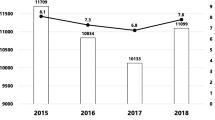Abstract
BACKGROUND: Although iatrogenic injury poses a significant risk to hospitalized patients, detection of adverse events (AEs) is costly and difficult.
METHODS: The authors developed a confidential reporting method for detecting AEs on a medicine unit of a teaching hospital. Adverse events were defined as patient injuries. Potential adverse events (PAEs) represented errors that could have, but did not result in harm. Investigators interviewed house officers during morning rounds and by e-mail, asking them to identify obstacles to high quality care and iatrogenic injuries. They compared house officer reports with hospital incident reports and patients’ medical records. A multivariate regression model identified correlates of reporting.
RESULTS: One hundred ten events occurred, affecting 84 patients. Queries by e-mail (incidence rate ratio [IRR]=0.16; 95% confidence interval [95% CI], 0.05 to 0.49) and on days when house officers rotated to a new service (IRR=0.12; 95% CI, 0.02 to 0.91) resulted in fewer reports. The most commonly reported process of care problems were inadequate evaluation of the patient (16.4%), failure to monitor or follow up (12.7%), and failure of the laboratory to perform at test (12.7%). Respondents identified 29 (26.4%) AEs, 52 (47.3%) PAEs, and 29 (26.4%) other house officer-identified quality problems. An AE occurred in 2.6% of admissions. The hospital incident reporting system detected only one house officer-reported event. Chart review corroborated 72.9% of events.
CONCLUSIONS: House officers detect many AEs among inpatients. Confidential peer interviews of front-line providers is a promising method for identifying medical errors and substandard quality.
Similar content being viewed by others
References
Brennan TA, Leape LL, Laird NM et al. Incidence of adverse events and negligence in hospitalized patients. New Engl J Med. 1991;324:370–6.
Leape LL, Brennan TA, Laird N et al. The nature of adverse events in hospitalized patients. New Engl J Med. 1991;324:377–84.
Andrews LB, Stocking C, Krizek T et al. An alternative strategy for studying adverse events in medical care. Lancet. 1997;349:309–13.
Bates DW, Spell N, Cullen DJ, et al. The costs of adverse drug events in hospitalized patients. JAMA. 1997;277:307–11.
Bates DW, Cullen DJ, Laird N, et al. Incidence of adverse drug events and potential adverse drug events. JAMA. 1995;274:29–34.
Cullen DJ, Bates DW, Small SD, et al. The incident reporting system does not detect adverse drug events: A problem for quality improvement. Jt Comm J Qual Improv. 1995;21:541–52.
Iezzoni LI, Daley J, Heeren T, et al. Using administrative data to screen hospitals for high complication rates. Inquiry. 1994;31:40–55.
Iezzoni LI, Daley J, Heeren T, et al. Identifying complications of care using administrative data. Med Care. 1994;32:700–15.
Classen DC, Pestotnik SL, Evans RS, et al. Computerized surveillance of adverse drug events in hospital patients. JAMA. 1991;266:2847–51.
Bates DW, Leape LL, Cullen DJ, et al. Effect of computerized physician order entry and a team intervention on prevention of serious medication errors. JAMA. 1998;280:1311–5.
Weingart SN. House officer education and organizational obstacles to quality improvement. Jt Comm J Qual Improv. 1996;22:640–6.
Wu AW, Folkman S, McPhee SJ, et al. Do house officers learn from their mistakes? JAMA. 1991;265:2089–94.
Welsh CH, Pedot RP, Anderson RJ. Use of morning report to enhance adverse event detection. J Gen Intern Med. 1996;11:454–60.
O’Neil AC, Petersen LA, Cook F et al. Physician reporting compared with medical-record review to identify adverse medical events. Ann Intern Med. 1993;119:370–6.
Leape LL, Bates DW, Cullen DJ, et al. Systems analysis of adverse drug events. JAMA. 1995;274:35–43.
Caplan RA, Posner KL, Cheney FW. Effect of outcome on physician judgments of appropriateness of care. JAMA. 1991;265:1957–60.
Leape LL. Error in medicine. JAMA. 1994;272:1851–7.
Author information
Authors and Affiliations
Corresponding author
Additional information
This research was supported in part by the CareGroup Center for Quality and Value. Preliminary data were presented at the Second Annenberg Conference on Enhancing Patient Safety and Reducing Errors in Health Care, Rancho Mirage, Calif, November 8–10, 1998, and an extended abstract published in the conference proceedings.
Rights and permissions
About this article
Cite this article
Weingart, S.N., Ship, A.N. & Aronson, M.D. Confidential clinician-reported surveillance of adverse events among medical inpatients. J GEN INTERN MED 15, 470–477 (2000). https://doi.org/10.1046/j.1525-1497.2000.06269.x
Issue Date:
DOI: https://doi.org/10.1046/j.1525-1497.2000.06269.x




